C.1.2 - 902 Willow St - permit drawings — original pdf
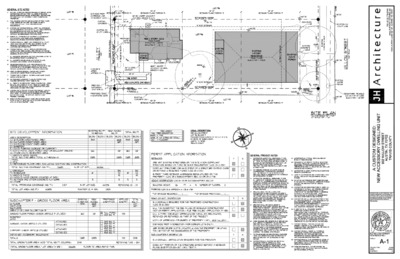
Backup

Backup

Rymer Residence 3204 Beverly Rd Austin, TX 78703 ARCHITECT: Norma Yancey, AIA SIDETRACKED STUDIO, PLLC 1806 Holly St Austin, Texas 78702 phone: 512.220.6865 norma@sidetracked-studio.com Dane & Lauren Rymer 3204 Beverly Rd Austin, TX 78703 LEGAL DESCRIPTION LOT 12 * & N3FT OF LOT 11 BLK 1 BRYKERWOODS E ZONING INFORMATION SF-3-NP NEIGHBORHOOD PLANNING AREA: - WINDSOR ROAD - Central West Austin Combined NPA RESIDENTIAL DESIGN STANDARDS OWNER INFORMATION INDEX OF DRAWINGS G1.0 G1.1 G3.0 G3.1 D1.0 A0.0 A1.0 A1.1 A1.2 A2.0 A2.1 COVER SHEET PROJECT INFORMATION AND GENERAL NOTES SCHEDULES SCHEDULES DEMOLITION PLAN SITE PLAN FIRST FLOOR PLAN SECOND FLOOR PLAN ROOF PLAN EXTERIOR ELEVATIONS EXTERIOR ELEVATIONS SQUARE FOOTAGE LOT SIZE 8183 SF FLOOR TO AREA RATIO: EXIST. NEW EXEMPT TOTAL 2,715 SF/ 8,183 SF = 33.18% < 40% FAR ALLOWED BY CODE IMPERVIOUS COVER: EXIST. NEW TOTAL FIRST FLOOR CONDITIONED SPACE: SECOND FLOOR CONDITIONED SPACE: THIRD FLOOR CONDITIONED SPACE: AREA W/ CEILINGS >15FT: GROUND FLOOR PORCH: BASEMENT: ATTIC: GARAGE: CARPORT: ACCESSORY BUILDINGS: TOTAL: FIRST FLOOR CONDITIONED SPACE: SECOND FLOOR CONDITIONED SPACE: THIRD FLOOR CONDITIONED SPACE: BASEMENT: ATTACHED COVERED PARKING: DETACHED COVERED PARKING: COVERED WOOD DECKS (100%): COVERED PATIO: COVERED PORCH: BALCONY: OTHER: TOTAL BUILDING AREA: TOTAL BUILDING COVERAGE: DRIVEWAY: SIDEWALKS & STEPS: UNCOVERED PATIO: UNCOVERED WOOD DECKS (50%): AC PADS & CONC FLATWORK: OTHER: TOTAL: 1624 0 - - 0 - - 238 - - 1862 1624 0 - - 238 - - 0 - - - 1862 1862 462 170 49 205.5 9 178 2935.5 309 744 - - 265 - - 0 - - 1318 309 744 - - 0 - - 265 - - - 1318 574 0 0 112 0 0 0 686 0 0 - - 265 - - 200 - - 465 1933 744 - - 0 - - 38 - - 2715 1933 744 - - 238 - - 265 - - - 3180 2436 462 170 161 205.5 9 178 3411 3,411 SF/ 8,183 SF = 41.7% < 45% IMPERVIOUS COVERAGE ALLOWED BY CODE Sidetracked Studio 1806 Holly St. Austin, Texas 512 220 6865 FIELD INSPECTION REQUIRED Prior to performing any bidding, new construction, and/or repairs, general contractor shall visit the site, inspect all existing conditions, and report any discrepancies to the architect. 05.24.21 i e c n e d s e R r e m y R d R y l r e v e B 4 0 2 3 …

Backup
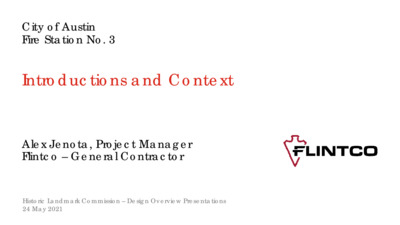
City of Austin Fire Station No. 3 Introductions and Context Alex Jenota, Project Manager Flintco – General Contractor Historic Landmark Commission – Design Overview Presentations 24 May 2021 Outline Introductions and Context Alex Janota, Project Manager Flintco – General Contractor Structural Damage Barry Krieger, Principal JQ Infrastructure – Structural Engineer Cost Implications and Alternatives Michelle Noriega, Project Manager City of Austin – Client Design Proposal Rob Robbins, Studio Director WestEast Design Group – Architect The Plan Forward Tony Haden, Division Chief Austin Fire Department – End User Context Location: 201 West 30th St Currently, all fire trucks are being parked outside the apparatus bay. Recent changes to the floodplain maps cause a significant portion of the building to be in the floodplain. Overview Construction completed on February 21, 1957 Architect: Roy Thomas Does not have any Landmark designations at present Adjacent to the Aldridge Place Historic District Historic An historic survey of the area was conducted. This building was identified in the survey. Recommendations for landmark were included. Reasoning: Possesses integrity and significance in Postwar Infrastructure Expansion. Neighborhood Engagement We presented the design proposal to the North University Neighborhood Association (NUNA) and the Aldridge Place Historic District. Meeting conducted through Zoom on May 3, 2021. Follow up questions were answered through email. Repairable Not Repairable Damage The building has suffered two types of structural damage: 1) General wear and tear based on age. (entire structure) 2) Overstressing of the foundation due to parking trucks that are heavier than the original design load. (apparatus bay only) Shore up and preserve Demolish and replace Intent For the areas that have just suffered age- related wear and tear, the intent is to shore up that portion of the structure and preserve it. For the apparatus bay, the intent is to demolish the portion of the building that is beyond repair and replace it with a new structure that is sensitive but of its time. Goals and Objectives 1) Save the historic fabric that can be saved and put it in good structural standing for the future. 2) Preserve the original historic use/function of the building. 3) Provide the Fire Department and EMS with the modern facility they need to operate effectively and efficiently for decades to come thus providing vital life-safety services to the area. 4) Get the fire trucks parked indoors for protection of the equipment, speed of response times, and aesthetic …
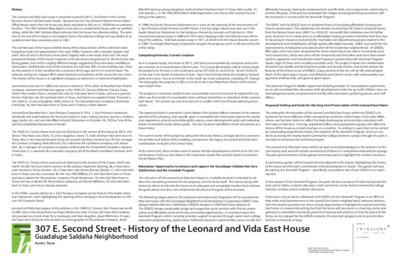
Backup

SPECIAL CALLED MEETING MONDAY, April 26, 2021 HUMAN RIGHTS COMMISSION MINUTES The Human Rights Commission convened in a Special Called meeting on Monday, April 26, 2021 via teleconference in Austin, Texas. Chair Sareta Davis called the Board Meeting to order at 5:44 p.m. Board Members in Attendance: Chair Davis, Vice Chair Jamarr Brown, Commissioner Breckenridge, Commissioner Garry Brown, Commissioner Caballero, Commissioner Casas, Commissioner Griffith, Commissioner Museitif, and Commissioner Santana. Staff in Attendance: Jonathan Babiak, Human Resources Coordinator, Office of Civil Rights CITIZEN COMMUNICATION: GENERAL None 1. APPROVAL OF MINUTES a. The minutes from the regular meeting of March 22, 2021 were approved on a vote of 9-0: Chair Davis motion, Commissioner Garry Brown second. Voting in favor were Chair Davis, Vice Chair Jamarr Brown, Commissioner Breckenridge, Commissioner Garry Brown, Commissioner Caballero, Commissioner Casas, Commissioner Griffith, Commissioner Museitif, and Commissioner Santana. Commissioner Areche and Commissioner Weigel were absent. b. The minutes from the special called meeting of April 19, 2021 were approved on a vote of 8-0-1: Chair Davis motion, Commissioner Griffith second. Voting in favor were Chair Davis, Vice Chair Jamarr Brown, Commissioner Breckenridge, Commissioner Garry Brown, Commissioner Caballero, Commissioner Casas, Commissioner Griffith, and Commissioner Santana. Commissioner Museitif abstained. Commissioner Areche and Commissioner Weigel were absent. 2. NEW BUSINESS a. Discussion and possible action on Human Rights Commission Officer Elections for Chair and Vice Chair. (Davis/Brown, J.) The Commission voted to override the term limits provisions in the bylaws for the election of the office of Chair by a vote of 9-0: Commissioner Garry Brown motion, Commissioner Museitif second. Voting in favor were Chair Davis, Vice Chair Jamarr Brown, Commissioner Breckenridge, Commissioner Garry Brown, Commissioner Caballero, Commissioner Casas, Commissioner Griffith, Commissioner Museitif, and Commissioner Santana. Commissioner Areche and Commissioner Weigel were absent. The Commission elected Sareta Davis to the office of Chair on a vote of 9-0: Commissioner Santana motion, Commissioner Griffith second. Voting in favor were 1 Chair Davis, Vice Chair Jamarr Brown, Commissioner Breckenridge, Commissioner Garry Brown, Commissioner Caballero, Commissioner Casas, Commissioner Griffith, Commissioner Museitif, and Commissioner Santana. Commissioner Areche and Commissioner Weigel were absent. The Commission elected Isabel Casas to the office of Vice Chair on a vote of 9-0: Chair Davis motion, Commissioner Garry Brown second. Voting in favor were Chair Davis, Vice Chair Jamarr Brown, Commissioner Breckenridge, Commissioner Garry Brown, Commissioner Caballero, Commissioner Casas, Commissioner Griffith, Commissioner Museitif, and Commissioner Santana. Commissioner Areche and Commissioner …
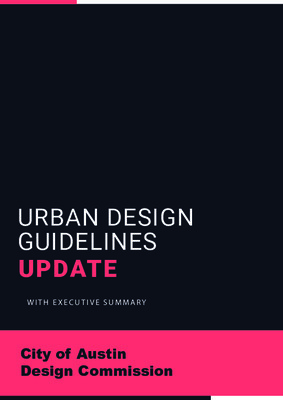
URBAN DESIGN GUIDELINES UPDATE W I T H E X E C U T I V E S U M M A R Y City of Austin Design Commission TABLE OF CONTENTS. Executive Summary 3 Background 5 Barriers 11 How the Update Will Be Accomplished 12 UDG EXECUTIVE SUMMARY The Urban Design Guidelines are a set of recommendations that promote architectural and urban design standards reflective of Austin’s shared values. When first created as the Downtown Austin Design Guidelines in 2000, these recommendations focused exclusively on projects located in Austin’s downtown. Then in 2008, in response to Austin’s growing urban core, there was an effort to make the guidelines broader to help shape the urban environment throughout the city as it grows. While this effort did rename the guidelines to reflect this intent, it did little else to promote their use beyond the Central Business District. Since this time, Austin’s urban core has expanded tremendously and the city has adopted many policies, initiatives, and plans to which the current UDG do not align with. Therefore, the Design Commission believes it is time to update the Urban Design Guidelines once again. The proposed update includes three main priorities. The first will focus on updating the UDG to have a broader applicability throughout Austin’s urban core, and therefore, the ability to serve a wider range of project types. Secondly, the update will better align the UDG with current community goals; including, but not limited to, adopted city polices related to affordability, connectivity, equity, environment, and mobility. Lastly, the update will seek to bring more clarity to the guidelines by creating a more inviting and user-friendly document that all Austinites can seek insight from, and resulting in a more predictable review process.” It is proposed that the update be accomplished in three phases. Phase I is the preparation phase, it will consist of crafting a guiding narrative, defining the core values, creating a community engagement plan, forming Working Groups, selecting Community Ambassadors, and establishing the overall work timeline. Austin’s urban core has expanded tremendously and the city has adopted many policies, initiatives, and plans to which the current UDG do not align with 3 Prepared by COA Design CommissionUrban Design Guidelines Updatȅ EXECUTIVE SUMMARY Phase II will be the creation phase, where the Community Ambassadors will begin outreach and reporting back and the Working Groups will begin drafting the guidelines. At the end …

2901 Bee Caves Road, Box L Austin, Texas 78746 Telephone: (512) 297-5516 Facsimile: (512) 320-9974 Bret C. Doyal Attorney and Counselor at Law Veronica Esquivel Legal Assistant Via email to Amber.allen@austintexas.gov May 24, 2021 Ms. Amber Allen Historic Preservation Society City of Austin Re: 1601 Canterbury Street, Austin, Texas – Request for Rescheduling of May 24, 2021 Hearing Dear Ms. Allen: I am writing on behalf of Ms. Amanda Estrada who is the occupant of 1601 Canterbury Street, Austin, Texas. It is my understanding that this property is scheduled to come before you this evening for consideration on whether or not the house may be demolished. I represent Ms. Estrada who resides at 1601 Canterbury Street, Austin, Texas. The property was in Ms. Estrada’s family for over 50 years, and she believes the house carries significant historical value to the City of Austin. Ms. Estrada was notified of today’s hearing and she reports that she received this notice of Thursday of last week. I just became aware of the hearing this past Friday. I am respectfully asking that today’s hearing be rescheduled to allow Ms. Estrada ample opportunity to gather her documents proving the property’s historical significance and provide these documents to you at your next hearing. Thank you for your time and attention to this matter. Respectfully, Bret C. Doyal
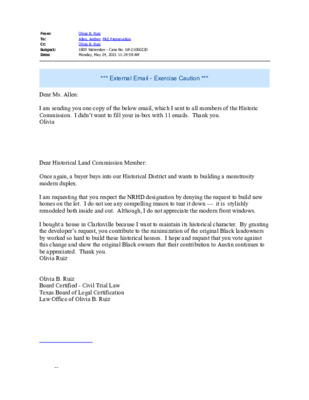
From: To: Cc: Subject: Date: Olivia B. Ruiz Allen, Amber; PAZ Preservation Olivia B. Ruiz 1805 Waterston - Case No. GF-21060230 Monday, May 24, 2021 11:24:58 AM *** External Email - Exercise Caution *** Dear Ms. Allen: I am sending you one copy of the below email, which I sent to all members of the Historic Commission. I didn’t want to fill your in-box with 11 emails. Thank you. Olivia Dear Historical Land Commission Member: Once again, a buyer buys into our Historical District and wants to building a monstrosity modern duplex. I am requesting that you respect the NRHD designation by denying the request to build new homes on the lot. I do not see any compelling reason to tear it down — it is stylishly remodeled both inside and out. Although, I do not appreciate the modern front windows. I bought a house in Clarksville because I want to maintain its historical character. By granting the developer’s request, you contribute to the minimization of the original Black landowners by worked so hard to build these historical houses. I hope and request that you vote against this change and show the original Black owners that their contribution to Austin continues to be appreciated. Thank you. Olivia Ruiz Olivia B. Ruiz Board Certified - Civil Trial Law Texas Board of Legal Certification Law Office of Olivia B. Ruiz -- This message and any attached documents or files contain information that is confidential and may be protected by attorney privilege. Unless you are a listed recipient of this message, you may not read, use, copy or disclose the contents of the message or any attachment to anyone. If you have received this message in error, please "reply to" the sender indicating your receipt of the message, and securely delete the message and any attachments. CAUTION: This email was received at the City of Austin, from an EXTERNAL source. Please use caution when clicking links or opening attachments. If you believe this to be a malicious and/or phishing email, please forward this email to cybersecurity@austintexas.gov.
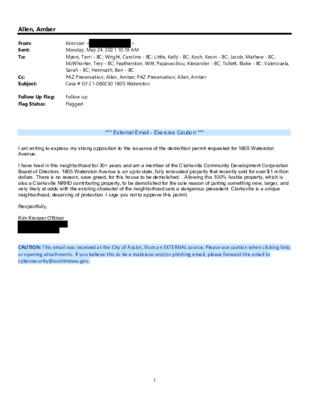
Allen, Amber From: Sent: To: Cc: Subject: Follow Up Flag: Flag Status: Follow up Flagged > kkronzer < Monday, May 24, 2021 10:19 AM Myers, Terri - BC; Wright, Caroline - BC; Little, Kelly - BC; Koch, Kevin - BC; Jacob, Mathew - BC; McWhorter, Trey - BC; Featherston, Witt; Papavasiliou, Alexander - BC; Tollett, Blake - BC; Valenzuela, Sarah - BC; Heimsath, Ben - BC PAZ Preservation; Allen, Amber; PAZ Preservation; Allen, Amber Case # GF 21-060230 1805 Waterston *** External Email - Exercise Caution *** I am writing to express my strong opposition to the issuance of the demolition permit requested for 1805 Waterston Avenue. I have lived in this neighborhood for 30+ years and am a member of the Clarksville Community Development Corporation Board of Directors. 1805 Waterston Avenue is an up-to-date, fully renovated property that recently sold for over $1 million dollars. There is no reason, save greed, for this house to be demolished. . Allowing this 100% livable property, which is also a Clarksville NRHD contributing property, to be demolished for the sole reason of putting something new, larger, and very likely at odds with the existing character of the neighborhood sets a dangerous precedent. Clarksville is a unique neighborhood, deserving of protection. I urge you not to approve this permit. Respectfully, Kim Kronzer O'Brien CAUTION: This email was received at the City of Austin, from an EXTERNAL source. Please use caution when clicking links or opening attachments. If you believe this to be a malicious and/or phishing email, please forward this email to cybersecurity@austintexas.gov. 1
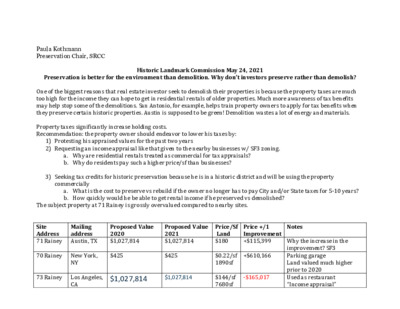
Paula Kothmann Preservation Chair, SRCC Historic Landmark Commission May 24, 2021 Preservation is better for the environment than demolition. Why don’t investors preserve rather than demolish? One of the biggest reasons that real estate investor seek to demolish their properties is because the property taxes are much too high for the income they can hope to get in residential rentals of older properties. Much more awareness of tax benefits may help stop some of the demolitions. San Antonio, for example, helps train property owners to apply for tax benefits when they preserve certain historic properties. Austin is supposed to be green! Demolition wastes a lot of energy and materials. Property taxes significantly increase holding costs. Recommendation: the property owner should endeavor to lower his taxes by: 1) Protesting his appraised values for the past two years 2) Requesting an income appraisal like that given to the nearby businesses w/ SF3 zoning. a. Why are residential rentals treated as commercial for tax appraisals? b. Why do residents pay such a higher price/sf than businesses? 3) Seeking tax credits for historic preservation because he is in a historic district and will be using the property commercially a. What is the cost to preserve vs rebuild if the owner no longer has to pay City and/or State taxes for 5-10 years? b. How quickly would he be able to get rental income if he preserved vs demolished? The subject property at 71 Rainey is grossly overvalued compared to nearby sites. Site Address 71 Rainey Austin, TX Price/Sf Land $180 Mailing address Proposed Value 2020 $1,027,814 $425 Proposed Value 2021 $1,027,814 $425 70 Rainey New York, NY 73 Rainey Los Angeles, CA $1,027,814 $1,027,814 Price +/1 Improvement +$115,399 Notes $0.22/sf 1890sf $144/sf 7680sf +$610,166 -$165,017 Why the increase in the improvement? SF3 Parking garage Land valued much higher prior to 2020 Used as restaurant “Income appraisal” 69 Rainey $568,008 $568,008 +4920 Javelinas SF3 PO Box Austin, TX $126/sf 4508 sf

Backup
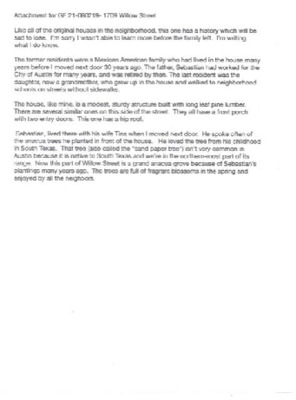
Backup
Play video
Play video
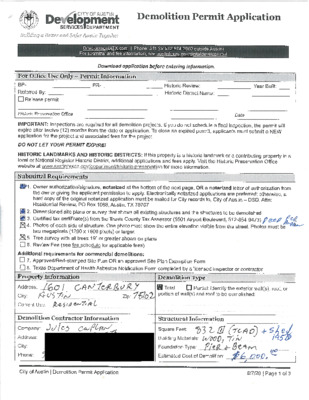
Backup
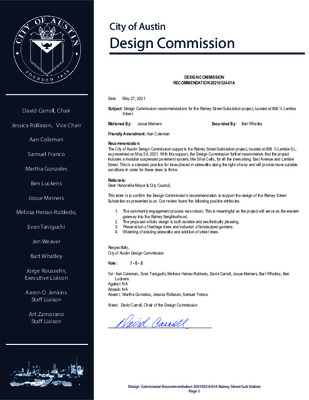
David Carroll, Chair Street. Jessica Rollason, Vice Chair Melissa Henao-Robledo, Aan Coleman Samuel Franco Martha Gonzales Ben Luckens Josue Meiners Evan Taniguchi Jen Weaver Bart Whatley Jorge Rousselin, Executive Liaison Aaron D. Jenkins Staff Liaison Art Zamorano Staff Liaison City of Austin Design Commission DESIGN COMMISSION RECOMMENDATION 20210524-01A Date: May 27, 2021 Subject: Design Commission recommendations for the Rainey Street Substation project, located at 806 ½ Lambie Josue Meiners Seconded By: Bart Whatley Motioned By: Friendly Amendment: Aan Coleman Recommendation: The City of Austin Design Commission supports the Rainey Street Substation project, located at 806 ½ Lambie St., as presented on May 24, 2021. With this support, the Design Commission further recommends that the project includes a modular suspended pavement system, like Silva Cells, for all the trees along East Avenue and Lambie Street. This is a standard practice for trees placed in sidewalks along the right-of-way and will provide more suitable conditions in order for these trees to thrive. Rationale: Dear Honorable Mayor & City Council, This letter is to confirm the Design Commission’s recommendation to support the design of the Rainey Street Substation as presented to us. Our review found the following positive attributes: 1. The community engagement process was robust. This is meaningful as the project will serve as the eastern gateway into the Rainey Neighborhood. 2. The proposed artistic design is both durable and aesthetically pleasing. 3. Preservation of heritage trees and inclusion of landscaped gardens. 4. Widening of existing sidewalks and addition of street trees. Respectfully, City of Austin Design Commission Vote: For: Aan Coleman, Evan Taniguchi, Melissa Henao-Robledo, David Carroll, Josue Meiners, Bart Whatley, Ben 7 - 0 - 0 Luckens Against: NA Abstain: NA Absent: Martha Gonzalez, Jessica Rollason, Samuel Franco Attest: David Carroll, Chair of the Design Commission 1 of 1 Design Commission Recommendation 20210524-01A Rainey Street Sub Station Page 1
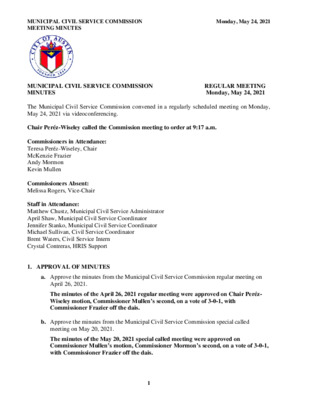
MUNICIPAL CIVIL SERVICE COMMISSION MEETING MINUTES Monday, May 24, 2021 REGULAR MEETING Monday, May 24, 2021 MUNICIPAL CIVIL SERVICE COMMISSION MINUTES The Municipal Civil Service Commission convened in a regularly scheduled meeting on Monday, May 24, 2021 via videoconferencing. Chair Peréz-Wiseley called the Commission meeting to order at 9:17 a.m. Commissioners in Attendance: Teresa Peréz-Wiseley, Chair McKenzie Frazier Andy Mormon Kevin Mullen Commissioners Absent: Melissa Rogers, Vice-Chair Staff in Attendance: Matthew Chustz, Municipal Civil Service Administrator April Shaw, Municipal Civil Service Coordinator Jennifer Stanko, Municipal Civil Service Coordinator Michael Sullivan, Civil Service Coordinator Brent Waters, Civil Service Intern Crystal Contreras, HRIS Support 1. APPROVAL OF MINUTES April 26, 2021. a. Approve the minutes from the Municipal Civil Service Commission regular meeting on The minutes of the April 26, 2021 regular meeting were approved on Chair Peréz- Wiseley motion, Commissioner Mullen’s second, on a vote of 3-0-1, with Commissioner Frazier off the dais. b. Approve the minutes from the Municipal Civil Service Commission special called meeting on May 20, 2021. The minutes of the May 20, 2021 special called meeting were approved on Commissioner Mullen’s motion, Commissioner Mormon’s second, on a vote of 3-0-1, with Commissioner Frazier off the dais. 1 MUNICIPAL CIVIL SERVICE COMMISSION MEETING MINUTES Monday, May 24, 2021 2. HEARING a. Conduct a hearing on the appeal filed by Thomas Ellison regarding their Discharge from the Austin Water Utility. A hearing was conducted on the appeal filed by Thomas Ellison regarding their Discharge from the Austin Water Utility. b. Deliberate in open or closed session, pursuant to 551.074 of the Texas Government Code (personnel exception), regarding the appeal of Thomas Ellison regarding their Discharge from the Austin Water Utility. Chair Peréz-Wiseley recessed the Municipal Civil Service Commission meeting to go to closed session at 4:35 p.m. The Commission deliberated in closed session on the appeal filed by Thomas Ellison regarding their Discharge from the Austin Water Utility. Closed session ended and Chair Peréz-Wiseley called the Municipal Civil Service Commission meeting back to order at 5:22 p.m. c. Possible action and decision on the appeal filed by Thomas Ellison regarding their Discharge from the Austin Water Utility. The motion to deny Thomas Ellison’s appeal and uphold the decision made by the City of Austin in the Discharge of Thomas Ellison was approved on Commission Mormon’s motion, Commissioner Mullen’s second, on a vote of 3-0-1, with Commissioner Frazier off the …
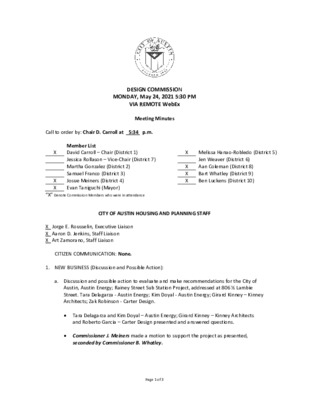
DESIGN COMMISSION MONDAY, May 24, 2021 5:30 PM VIA REMOTE WebEx Meeting Minutes Call to order by: Chair D. Carroll at 5:34 p.m. X X X Member List David Carroll – Chair (District 1) Jessica Rollason – Vice-Chair (District 7) Martha Gonzalez (District 2) Samuel Franco (District 3) Josue Meiners (District 4) Evan Taniguchi (Mayor) “X” Denote Commission Members who were in attendance X Jorge E. Rousselin, Executive Liaison X Aaron D. Jenkins, Staff Liaison X Art Zamorano, Staff Liaison CITIZEN COMMUNICATION: None. 1. NEW BUSINESS (Discussion and Possible Action): CITY OF AUSTIN HOUSING AND PLANNING STAFF X Melissa Hanao-Robledo (District 5) X X X Jen Weaver (District 6) Aan Coleman (District 8) Bart Whatley (District 9) Ben Luckens (District 10) a. Discussion and possible action to evaluate and make recommendations for the City of Austin, Austin Energy; Rainey Street Sub Station Project, addressed at 806 ½ Lambie Street. Tara Delagarza - Austin Energy; Kim Doyal - Austin Energy; Girard Kinney – Kinney Architects; Zak Robinson - Carter Design. • Tara Delagarza and Kim Doyal – Austin Energy; Girard Kinney – Kinney Architects and Roberto Garcia – Carter Design presented and answered questions. • Commissioner J. Meiners made a motion to support the project as presented, seconded by Commissioner B. Whatley. Page 1 of 3 • Commissioner A. Coleman made a friendly amendment to include a Silva Cell or similar systems beneath the landscaping. Commissioner J. Meiners and Commissioner B. Whatley accepted the friendly amendment. • The motion was approved [ 7 ayes, 0 nays] b. Courtesy Briefing on the City of Austin Palm District Planning Initiative, to be presented by Stevie Greathouse – City of Austin Housing and Planning Department. • Stevie Greathouse – City of Austin Housing and Planning Department provided a courtesy briefing of the City of Austin Palm District Planning Initiative. c. Courtesy Briefing on the Austin Land Development Code Functional Green component, to be presented by Pamela Abee-Taulli–City of Austin Development Services Department • Pamela Abee-Taulli–City of Austin Development Services Department provided a courtesy briefing on the Austin Land Development Code Functional Green component and answered questions. 2. COMMISSION-SPECIFIC BUSINESS (Discussion and possible action): a. Approval of April 26th meeting minutes. • Commissioner A. Coleman made a motion to approve the April 26th meeting minutes as distributed, seconded by Commissioner J. Meiners. • The motion was approved [ 7 ayes, 0 nays] b. Discussion and …
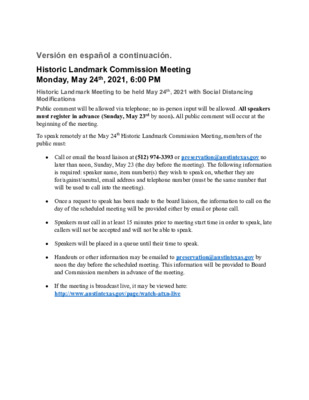
Versión en español a continuación. Historic Landmark Commission Meeting Monday, May 24th, 2021, 6:00 PM Historic Landmark Meeting to be held May 24th, 2021 with Social Distancing Modifications Public comment will be allowed via telephone; no in-person input will be allowed. All speakers must register in advance (Sunday, May 23rd by noon). All public comment will occur at the beginning of the meeting. To speak remotely at the May 24th Historic Landmark Commission Meeting, members of the public must: • Call or email the board liaison at (512) 974-3393 or preservation@austintexas.gov no later than noon, Sunday, May 23 (the day before the meeting). The following information is required: speaker name, item number(s) they wish to speak on, whether they are for/against/neutral, email address and telephone number (must be the same number that will be used to call into the meeting). • Once a request to speak has been made to the board liaison, the information to call on the day of the scheduled meeting will be provided either by email or phone call. • Speakers must call in at least 15 minutes prior to meeting start time in order to speak, late callers will not be accepted and will not be able to speak. • Speakers will be placed in a queue until their time to speak. • Handouts or other information may be emailed to preservation@austintexas.gov by noon the day before the scheduled meeting. This information will be provided to Board and Commission members in advance of the meeting. • If the meeting is broadcast live, it may be viewed here: http://www.austintexas.gov/page/watch-atxn-live Reunión del Historic Landmark Commission FECHA de la reunion (24 de mayo, 2021) La junta se llevará con modificaciones de distanciamiento social Se permitirán comentarios públicos por teléfono; no se permitirá ninguna entrada en persona. Todos los oradores deben registrarse con anticipación (23 de mayo, 2021 antes del mediodía). Todos los comentarios públicos se producirán al comienzo de la reunión. Para hablar de forma remota en la reunión, los miembros del público deben: • Llame o envíe un correo electrónico al enlace de la junta en (512) 974-3393 or preservation@austintexas.gov a más tardar al mediodía (el día antes de la reunión). Se requiere la siguiente información: nombre del orador, número (s) de artículo sobre el que desean hablar, si están a favor / en contra / neutral, dirección de correo electrónico (opcional) y un número de teléfono …